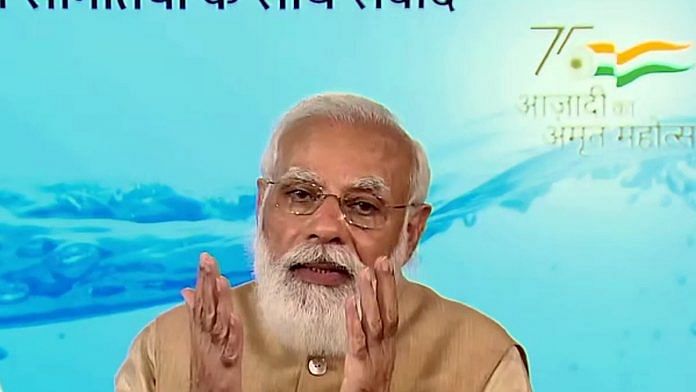New Delhi: The central government’s efforts to supply drinking water to every rural household under the Jal Jeevan Mission (JJM) could prevent the deaths of about 1.36 lakh children under the age of five in India every year, says a study co-authored by Nobel laureate Michael Kremer.
The report, ‘Potential Reduction in Child Mortality through Expanding Access to Safe Drinking Water in India’, was released by ‘The Development Innovation Lab’. Led by the University of Chicago, the lab aims at working on innovations with the potential to benefit millions of people in low- and middle-income countries.
Co-authored by Micheal Kremer, an American development economist at the University of Chicago who got the Nobel Prize in economics in 2019, the report says that “this will require that water delivered through the JJM is free of microbial contamination”.
Diarrhoea is “the third most common responsible disease for under-five mortality in India”, it says.
“Water treatment is a cost-effective way to reduce diarrheal [sic] disease and child mortality. A recent meta-analysis of 15 randomised controlled trials conducted by Kremer et al (2022) suggests that the expected reduction in all-cause under-5 mortality from water treatment is around one in four,” the study says. “This meta-analysis also suggests that water treatment is among the most cost-effective ways to reduce child mortality.”
Researchers admitted that their calculation was “conservative” given that it assumes that households without access to “safely managed water have child mortality rates 25 per cent higher than those which do”.
“However, the mortality difference between these households would likely be larger, if households with access to safely managed water also have better nutrition, or access to better medical care,” the study says.
India’s child mortality rate — the probability of a child dying between birth and exactly 5 years of age, expressed per 1,000 live births — was 41.9, according to the National Family Health Survey-5.
Launched in 2019, the Jal Jeevan Mission aims to supply 55 litres of water per person every day to each rural household through functional household tap connections at affordable service delivery charges by 2024. The aim is to improve the living standards of rural communities, the mission’s website says.
Out of the Rs 3.6 lakh crore earmarked for the ‘Nal Se Jal’ scheme for five years starting 2019, states and centre will equally share the expense. For union territories, the central government will provide 100 per cent funding.
So far, Goa, Telangana, Haryana, Dadra and Nagar Haveli, Daman and Diu, Puducherry, Andaman, and Nicobar Island have achieved 100 per cent tap water in households.
According to government data, only 3.23 crore (17 per cent) of 19.22 crore rural households had tap water connections when the mission was launched three years ago. The ministry’s target is to cover the remaining 16 crore (83 per cent) households by 2024.
Also Read: Clean water in all 19 crore rural homes by 2024 is Modi’s next big election play
Safe, cost-effective piped-water
For the study, the authors use data from the Global Burden of Disease — a global research programme that assesses health loss from hundreds of diseases, injuries, and risk factors — and WHO/UNICEF’s Joint Monitoring Programme for Water Supply, Sanitation and Hygiene.
The study, which was also co-authored by Akanksha Saletore, Witold Więcek, and Arthur Baker, says providing piped water was an important step in reducing diarrhoeal diseases and child mortality in India in a cost-effective way. It was critical that the water be contamination-free, the study says.
“Even in cases where water is treated at a central location, negative pressure in pipes can cause contamination. For example, a 2019 study in Maharashtra found high rates (37 per cent) of E. coli contamination in piped water. Treatment of water closer to the point of use may be necessary in systems where water pressure is not constant,” it says.
E.coli is a bacteria normally found in the intestines of healthy people. Exposure to certain strains of the bacteria from either contaminated food or water can cause severe stomach cramps, bloody diarrhoea, and vomiting.
While geogenic contaminants — i.e., elevated concentrations of naturally occurring elements in groundwater — such as arsenic, fluoride, and nitrate are “widespread in certain regions of India”, the most ubiquitous type of contamination is microbial.
Researchers used estimates from their earlier research about a reduction of child mortality from water treatment and adjusted them to the Indian context to reach their conclusion.
The study also talks how reaching as many people as possible with safe water have large net benefits. “We hope to work with the Ministry [of Jal Shakti] and assist in this effort by testing possible solutions to water quality treatment such as rechlorination,” the report says.
(Edited by Uttara Ramaswamy)
Also Read: India faces a severe water crisis & Modi govt can’t tackle it alone. Here’s what we can do



